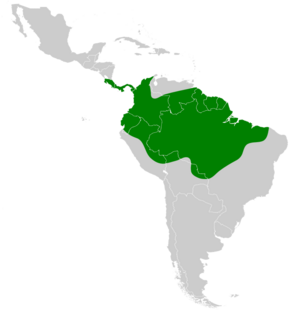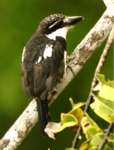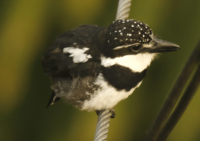Pied puffbird facts for kids
Quick facts for kids Pied puffbird |
|
|---|---|
 |
|
| In Mindo, Ecuador | |
| Conservation status | |
| Scientific classification | |
| Genus: |
Notharchus
|
| Species: |
tectus
|
 |
|
| Synonyms | |
|
Bucco tectus |
|
The pied puffbird (Notharchus tectus) is a type of bird that belongs to the Bucconidae family. This family includes puffbirds, nunlets, and nunbirds. You can find the pied puffbird in many countries, including Bolivia, Brazil, Colombia, Costa Rica, Ecuador, French Guiana, Guyana, Nicaragua, Panama, Peru, Suriname, and Venezuela.
Contents
About the Pied Puffbird's Name
The pied puffbird got its scientific name, Notharchus tectus, a long time ago. The word Notharchus comes from ancient Greek words meaning "sluggish" and "leader." The word tectus is Latin for "covered" or "hidden."
Scientists group animals into different types. For the pied puffbird, there are three main types, called subspecies. Some experts even think one of these types, subtectus, is a completely separate species, which they call the "lesser pied puffbird."
The three recognized subspecies are:
- N. t. subtectus
- N. t. picatus
- N. t. tectus
What Does the Pied Puffbird Look Like?
The pied puffbird is a small bird, usually about 14 to 17 centimeters (5.5 to 6.7 inches) long. It weighs between 21 and 40 grams (0.7 to 1.4 ounces).
Most of its upper body is shiny black, and its belly is white. It has a white line that goes from its beak, past its eye. You might also see small white spots on its head and a big white patch on its shoulders. There's also some white near the base and end of its tail.
A wide black band separates its chest from its belly. The sides of its body have black and white stripes. The different subspecies have slight differences in size and how much white they have on their feathers. For example, N. t. subtectus is smaller and has less white on its head.
Where Do Pied Puffbirds Live?
Pied puffbirds live in various places across Central and South America.
- The N. t. tectus subspecies lives in southern Venezuela, the Guianas, and northern Brazil.
- N. t. picatus is found from southeastern Colombia down through eastern Ecuador and Peru, and into eastern Bolivia and west-central Brazil.
- N. t. subtectus lives from southeastern Nicaragua through Costa Rica and Panama, into north-central Colombia, and western Ecuador.
These birds usually stay in the same area all year, but sometimes they move around a bit depending on the season.
Pied puffbirds like many different kinds of places to live. They can be found in open grasslands called savannas, or inside and on the edges of tropical evergreen forests. They also live in forests that have grown back after being cut down, forests along rivers, old clearings, and even mangrove swamps. They usually prefer to stay high up in the trees. In Costa Rica, they seem to avoid very old, untouched forests and prefer more open areas, usually below 300 meters (about 980 feet) in elevation. In other places, they can be found as high as 1,000 meters (about 3,280 feet).
Pied Puffbird Behavior
How Pied Puffbirds Find Food
The pied puffbird is a hunter! It mostly eats arthropods, which are creatures like spiders and insects. It hunts by sitting on an open branch, usually high in the trees. When it spots something, it quickly flies out to catch its prey. Scientists have seen them eat many different kinds of spiders and insects.
Reproduction and Life Cycle
The time of year when pied puffbirds lay eggs changes depending on where they live. You might find them breeding almost any month in some parts of their large home range.
They build their nests by digging a hole in a termitarium (a termite nest) that is built in a tree. These nests can be anywhere from 4 to 25 meters (about 13 to 82 feet) above the ground. A female pied puffbird usually lays two eggs. We don't know if both parents sit on the eggs to keep them warm, but both mother and father birds help feed the young chicks once they hatch.
Pied Puffbird Sounds
The song of the pied puffbird sounds a little different depending on the subspecies. The N. t. tectus and N. t. picatus subspecies make a "thin but loud, high-pitched, bat-like series of whistles." It sounds like "tee-oo" or "pweee pweee pweee" in different patterns. The N. t. subtectus subspecies has a sound that is "apparently higher-pitched and possibly more piping, [and] less modulated."
Pied Puffbird Status
The IUCN (International Union for Conservation of Nature) looks at how many of these birds are left. They consider the pied puffbird to be two separate species for their assessments. Both the "greater" (N. t. tectus/tecatus) and "lesser" (N. t. subtectus) pied puffbirds are listed as being of "Least Concern." This means they are not currently in danger of disappearing.
However, scientists believe that the number of these birds is slowly going down. Even though pied puffbirds live in at least one protected area in most countries, cutting down forests (deforestation) has affected their populations in places like Costa Rica and Ecuador.
Gallery





